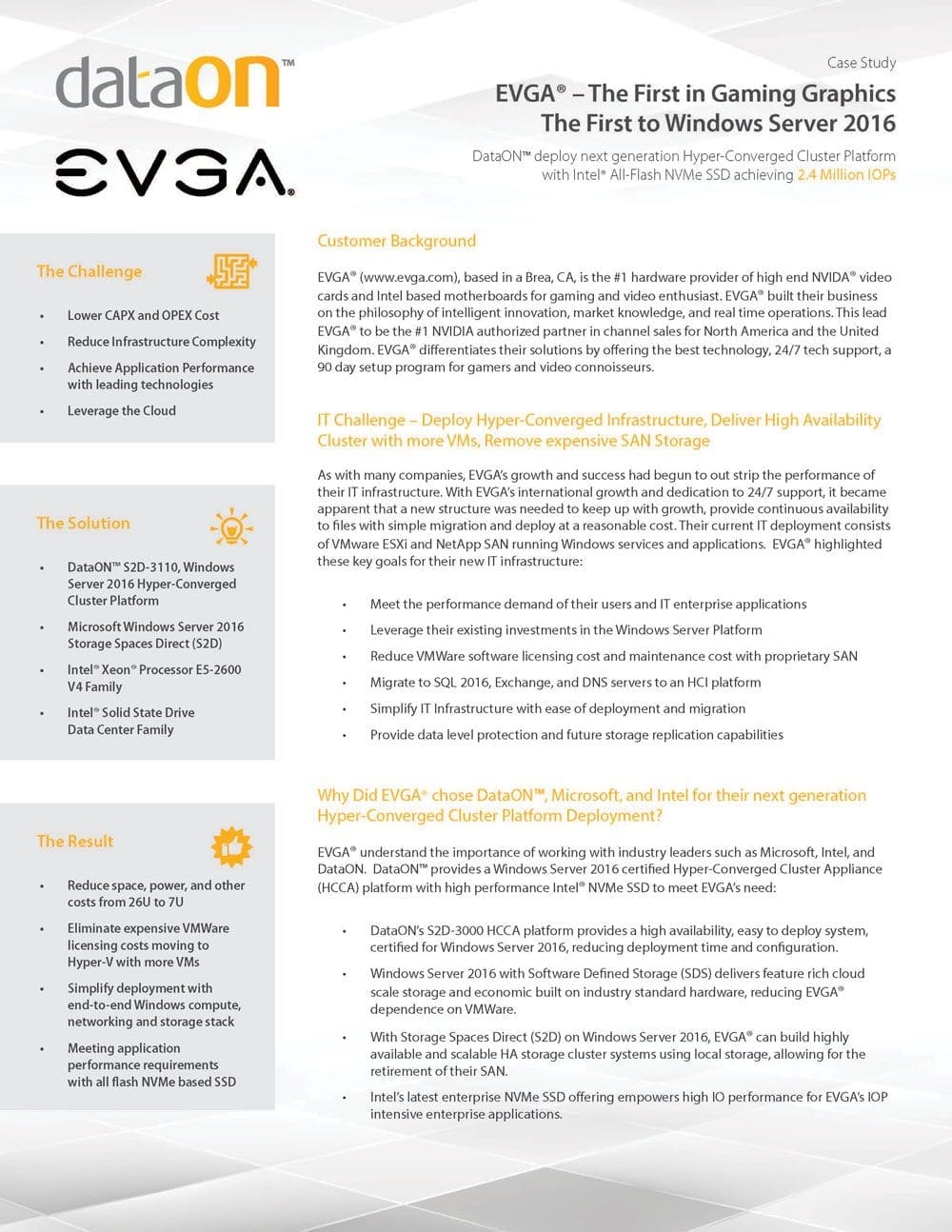The DataON™ S2D-3110 HCCA is built to optimize the full stack of Microsoft S2D in the Hyper-Converged platform. From Scale-Out File Server (SoFS) to Software Storage Bus to Storage and Networking hardware, this appliance runs on the cluster Shared Volumes Resilient File System (ReFS) and uses high performance NVMe SSDs with SMB 3.0 networking to maximize performance and IOPS. The integrated S2D-3110 HCCA platform and DataON™ MUST™ (Management Utility Software Tools) Visibility and Management Framework delivers:
Performance
All Flash NVMe SSD achieving 2.4M IOPs in 4-Nodes Cluster
Virtualization
Support 40+ Hyper-V VMs per nodes up-to 16-Nodes per Clusters
Scalability
Delivering compute, networking and storage resources near-linear scalability
Simplicity
Simple out-of-box deployment and ease of installation
Management
DataON™ Infrastructure Visibility and Management
- Preconfigured 4-Nodes S2D-3110 HCCS Cluster – Expand performance and capacity with scalability and operational exibility.
- Industry Leading Application Performance – The S2D-3110 HCCA with four (4x) cluster nodes is capable of providing over 2.4 million IOPS (running VM Fleet) using the latest all Flash NVMe based SSD technology to scale I/O intensive workloads.
- Hyper-V Virtualization Hosting – Each S2D-3110 HCCA can support up to 40+ Hyper-V virtual machines per node, up to 16 nodes per cluster.
- Storage and Network with SMB 3.0 over RDMA – Delivers highest throughput, lowest latency, and increases CPU efficiency.
- Hyper-Converged Scalability – Incremental compute, networking, and storage resources provide near-linear scalability. Each HCCA can also be expanded in capacity via 12G SAS JBODs for further storage expansion.
- Automated Deployment – Automated out-of-box work flow accelerates time to deployment for Windows Server 2016, Storage Spaces Direct, and Storage Replica environments.
- Integrated Data Protection and Guarded Fabric – Fully support Windows Server 2016 with Shielded VM and TPM 2.0 trusted attestation for security and business continuity.
- Built for Microsoft Services and I/O Intensive Applications – Ideal for VDI, SQL, Dynamics ERP, and Business Intelligence deployments.
 Appliance Node1U Rack Mount
Appliance Node1U Rack Mount Processor(2) Intel® Xeon® E5-2600v4 family, Max. TDP 145W up to 22 Cores
Processor(2) Intel® Xeon® E5-2600v4 family, Max. TDP 145W up to 22 Cores ChipsetIntel® C610
ChipsetIntel® C610 Memory(20) DIMM slots, 2133/2400 MHz DDR4 RDIMM, up to 640GB
Memory(20) DIMM slots, 2133/2400 MHz DDR4 RDIMM, up to 640GB- Storage Drive(10) 2.5” hot-plug PCIe-base NVMe SSD
 Expansion Slot(2) NVMe Cache Tier & (8) NVMe Capacity Tier (1) PCIe 3.0 x8; & (2) PCIe 3.0 x8 LP
Expansion Slot(2) NVMe Cache Tier & (8) NVMe Capacity Tier (1) PCIe 3.0 x8; & (2) PCIe 3.0 x8 LP NetworkDual-port 10GbE RDMA NIC (RoCE/iWARP), up to 40/100GbE
NetworkDual-port 10GbE RDMA NIC (RoCE/iWARP), up to 40/100GbE Power & Cooling(1+1) 750W hot-plug & Redundant & (6) dual-rotor fans
Power & Cooling(1+1) 750W hot-plug & Redundant & (6) dual-rotor fans TPMTPM 2.0
TPMTPM 2.0 Microsoft Software Defined OfferingHyper-Converged Premium Hyper-Converged Standard S2D Storage
Microsoft Software Defined OfferingHyper-Converged Premium Hyper-Converged Standard S2D Storage Appliance ProfileAll Flash NVMe SSD
Appliance ProfileAll Flash NVMe SSD Scale for ClusterFour Nodes per S2D-3110 Cluster, up to 16
Scale for ClusterFour Nodes per S2D-3110 Cluster, up to 16 ManagementDataON™ MUST™
ManagementDataON™ MUST™

DataON MUST
Infrastructure Visibility and Management Tool
DataON S2D-3000 solutions are integrated with DataON MUST, providing SAN-like storage monitoring features for customers deploying Windows Server 216 Software-Defined Solutions.
Dashboard Level Metrics
MUST delivers SAN-like storage monitoring features through a single pane of glass, providing real-time dashboard level metrics for IOPS, latency, throughput on cluster nodes and volumes.
System Alerts
With system alerts based on Windows Health Service faults and SAN-like call home services, systems administrators will be automatically notified of hardware failures, configuration issues and resource saturation.
Fully Integrated with SM-API
MUST utilizes the Windows Storage Health Service API built into Windows Server 2016 to monitor Storage Spaces Direct.
Multiple Tiers of Storage Visibility and Monitoring
DataON MUST enables IT teams to easily deploy and manage Microsoft Software-Defined Solutions.
- SDDC & Hyper-Converged Infrastructure TierServices subtitleWith the initial focus on storage monitoring and visibility, MUST provides system level information for performance, capacity, hardware inventory and faults/alerts. MUST gives you a dashboard level view of your operational visibility, analytics, infrastructure health management, storage systems metrics and event logging insights.
- Hyper-Converged Cluster Appliance/Node TierAt the hyper-converged cluster appliance (HCCA) node level, MUST provides pool, volume and device level performance, health and operational analytics for HCCA clusters. This enables you to provide proactive systems maintenance and understand requirements for workload migrations.
- Systems and Storage Services Audit Log TierAt the systems and storage services audit level, we provide the detailed logging level visibility for events to perform root cause analysis and export analytics source data.
- SAN-like Call Home Service SupportWindows administrators can now have automated email alerts sent to key contacts based on the Health Service faults in Windows Server 2016. You can also leverage SNMP traps for 3rd party monitoring including disk and hardware replacement.






